Notes from Product Tonic Unconference 2021
Building Bridges for Product Leadership in Southeast Asia
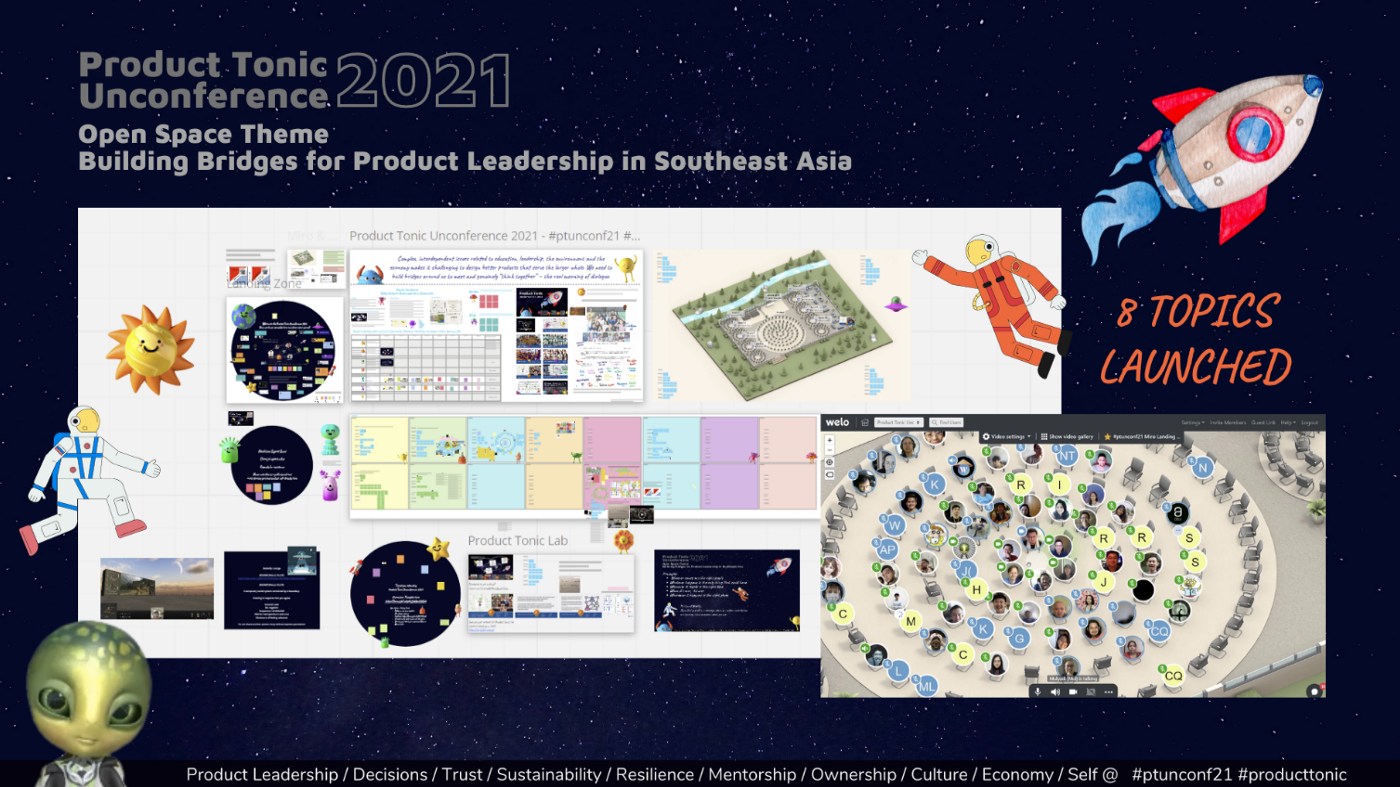
Being participants of Product Tonic Lab, we’re exposed to various approaches to establish dialogue and collaboration from within small groups using The Circle Way, The World Cafe, Fishbowl Conversation to the large group through this Product Tonic Unconference, which is based on the Open Space Technology method.
This by far is the most participative and engaging virtual dialogue session and environment I’ve attended — no mean feat given engagement and interaction have been the largest challenge when it comes to virtual events. Plus, without the usual awkwardness that infiltrates breakout sessions!
Introductions and Check-In to Unconference space
For those who are new to Open Space & Unconference concept:
What is Unconference?
An unconference is a participant driven meeting with high level structure to provide a clear sense of purpose but without predefined topics to create an informal and open atmosphere. The actual topics are generated on the spot by the participants based on the overall theme proposed by the organizer while breakout discussion groups are formed dynamically.
Why Unconference?
- Less up-front planning. Organiser does not need to set up a detailed agenda ahead of time.
- Greater flexibility. The issues that are most important to people will be raised, attended and discussed by the participants best capable of getting something done about them. Participants co-create the agenda and may discover unexpected topics that are of relevance.
- Spontaneous conversations and higher energy levels. The open space format encourages informal conversations to get to know each other, exchange knowledge, and build trust. Participants will likely feel engaged and energized by the process given the focus on issues that matter to them.
Simple rules to remember when attending the Unconference (known as Open Space Principles):
- Whoever comes is the right people
- Whenever it starts is the right time
- Whatever happens is the only thing that could have
- When it’s over, it’s over
- Wherever it happens is the right place
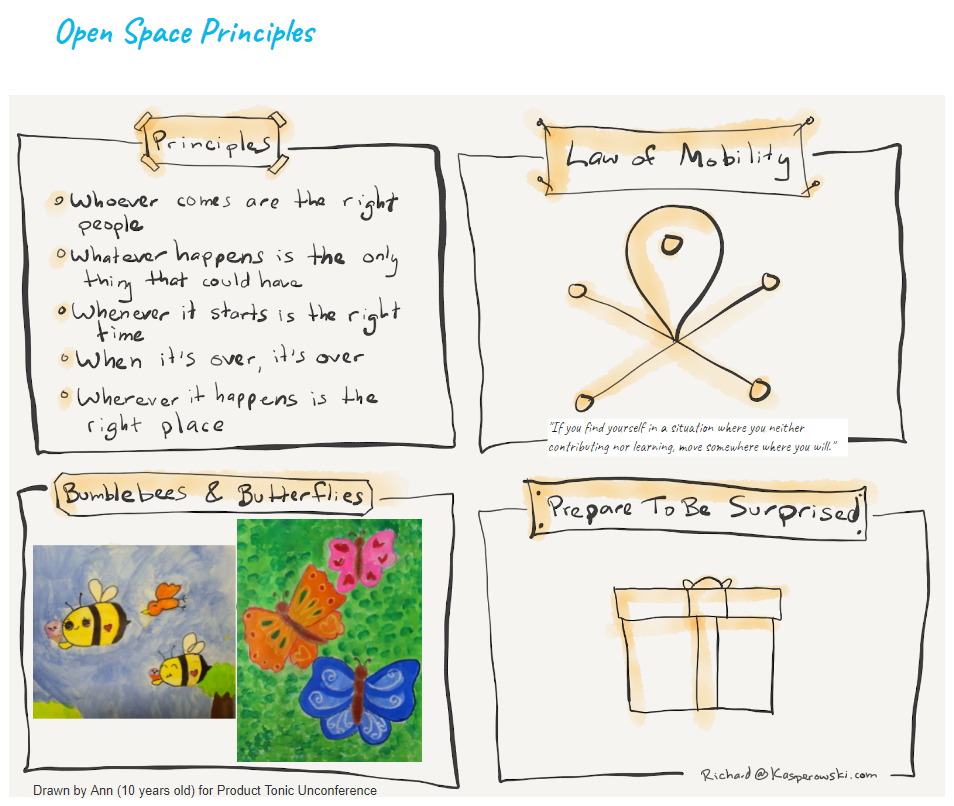
Above principles are also complemented with the “Law of Mobility” : If at any time during our time together you find yourself in any situation where you are neither learning nor contributing, go someplace else. This means all participants are given both the right and the responsibility to maximize their own learning and contribution, which the Law assumes only participants themselves can ultimately judge and control.
The Theme
The guiding theme for this 4th Product Tonic Unconference held on Saturday 23rd Oct is “Building Bridges for Product Leadership in Southeast Asia” which is about exploring how we can create a space for co-creation to bridge young/junior professionals, busy/senior professionals and what needs dialogue and co-generative action.
The Unconference agenda is structured as following:
- 10:00 Introductions and Check-In to Unconference space
- 10:15 User Experience Fishbowl with Product Leaders in Southeast Asia
- 11:05 Mindful Movement with Teresa Thuy Pham
- 11:20 to 14:00 Open Space Begins
- 14:00 to 14:30 Unconference Closing and Check-Out
A total of 108 participants signed up with 58 participants coming from Southeast Asia communities of practice for product people. Besides enriching conversation around Product Leadership / Decisions / Trust / Sustainability / Resilience / Mentorship / Ownership / Culture / Economy / Self — The Unconference also making a difference by donating the proceeds towards providing for university education for the children from Baan Dada — a safe home for disadvantaged children situated on the border of Thailand and Myanmar.
User Experience Fishbowl Conversations with Product Leaders in Southeast Asia
This is a facilitated conversation with Sander Veraar, Jeremy Ong, Tomas Li, Huishan Lim, Mike Dickinson who have contributed their time and energy over the years, nurturing conversations in the Southeast Asia product space.
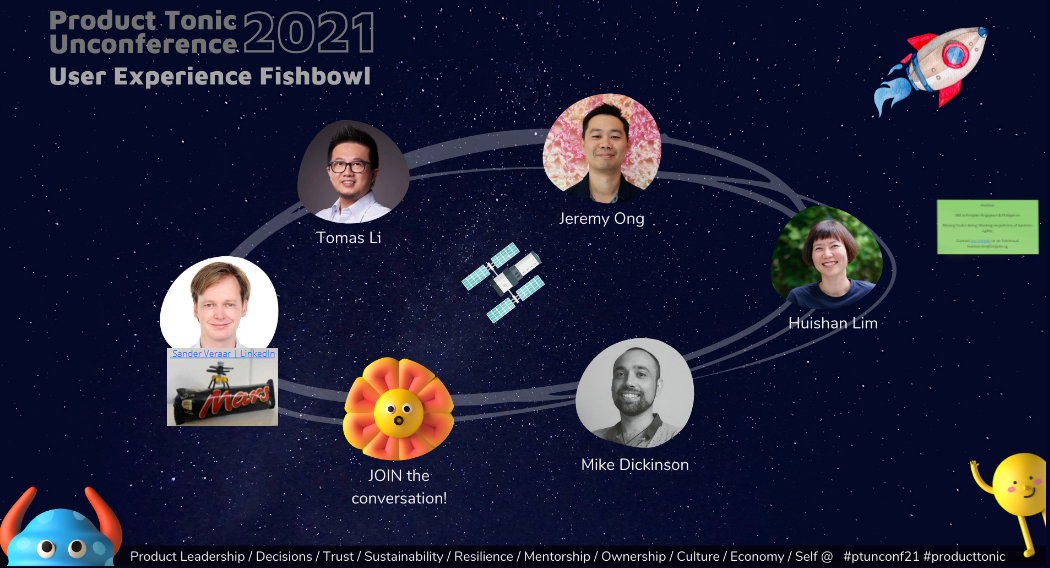
The Unconference notes is shared according to Chatham House Rule
Check In — What words would you use to describe where your head is? And where your heart is?
- Collective exuberance, at ease…
Self — Over the past year, how have you taken care of yourself?
- Spending time with family and create time for self-reflect
- Being appreciative that we’re in a place that is relatively safe. Do more exercise.
- Adjusting to a new normal — learning mindfulness; checking in “inside” since can’t travel outside; creating more opportunities for learning
- Deliberately minimise screen time and virtual meets; commit to some major personal decisions
- Develop awareness of things to be grateful of and being kind to yourself
Culture — What do you think of this statement “Culture is the interactions and relations between people”
- We were not born with culture — We were imposed and immersed in it which shaped who we are. Still, culture can also be a choice.
- Culture is a common belief as a group of people in organisations and society — what you prefer & not to prefer. There’s always something new to discover and relearn.
- Culture is like “the water that the fish lives in” — you don’t really see and feel but it governs & influences everything. Interactions and relations between people will happen within this environment along with our own individual agency as to how we choose to interact with it. Whatever you do will have ripple effect
- Culture is permeating — you as an individual have the choice to help determine the ripples. The influence can come from within yourself or imposed by the world if you decide not to do anything about it. You don’t have to wait to be given (hierarchical) leadership to make and influence
Who defines the culture?
- While top-down company culture can happen (wanted by upper management) — In reality, it is not what they say but what they do.
- Culture can come from bravery of people who are proud of who they are, self-confident in what they do, have the belief and take action. It is about the behavior of the individuals around you. Individuals can create team cultures, expand into organisation cultures and eventually company culture.
- We often underestimate our ability to define the culture. We can have a huge influence and impact on culture (particularly in teams and family) given our willingness to engage & lead by example.
- One important conversation to have is to establish explicit agreement about what the group culture should be. This will help minimise misunderstanding and frustration in doing what different members consider “right”
- Find ways to codify the culture so that it is not so fragile — cognition may change as people change.
- Culture is the sum and accumulation of spoken and unspoken language around values which doesn’t change much in organisation. Example, transparency as values will remain, but the act of respecting transparency may change as organisation grows. In other words, Culture always changes because people change but the values might stay the same.
- Values like destination, as you walk toward the destination, all the things you did and talk about becomes your culture with working agreement can be the “umbrella” to overcome challenges
Decisions — What is a significant decision you have made in the last year? How has it impacted you?
- Speaking out, giving yourself permission to create your own personal space and not to feel guilty about it
- Resilience — What is something you came across recently that gave you hope or inspiration?
- Wrote a book to codify organisation core values and stories to share with new hires
- People starts care more about social issues and welfare of others — there’s a lot more boldness and energy to harness
Check Out — What is your answer to life, universe and everything at this time in your life?
- 42 (The unconf is held week 42 of 2021!)
- We’re the universe’s self conscious — without us, the universe does not know it exists. Learning and understanding how the world works is just the universe trying to understand itself. Education is the number one most important thing; without it the universe will not know itself.
Mindful Movement with Teresa Thuy Pham
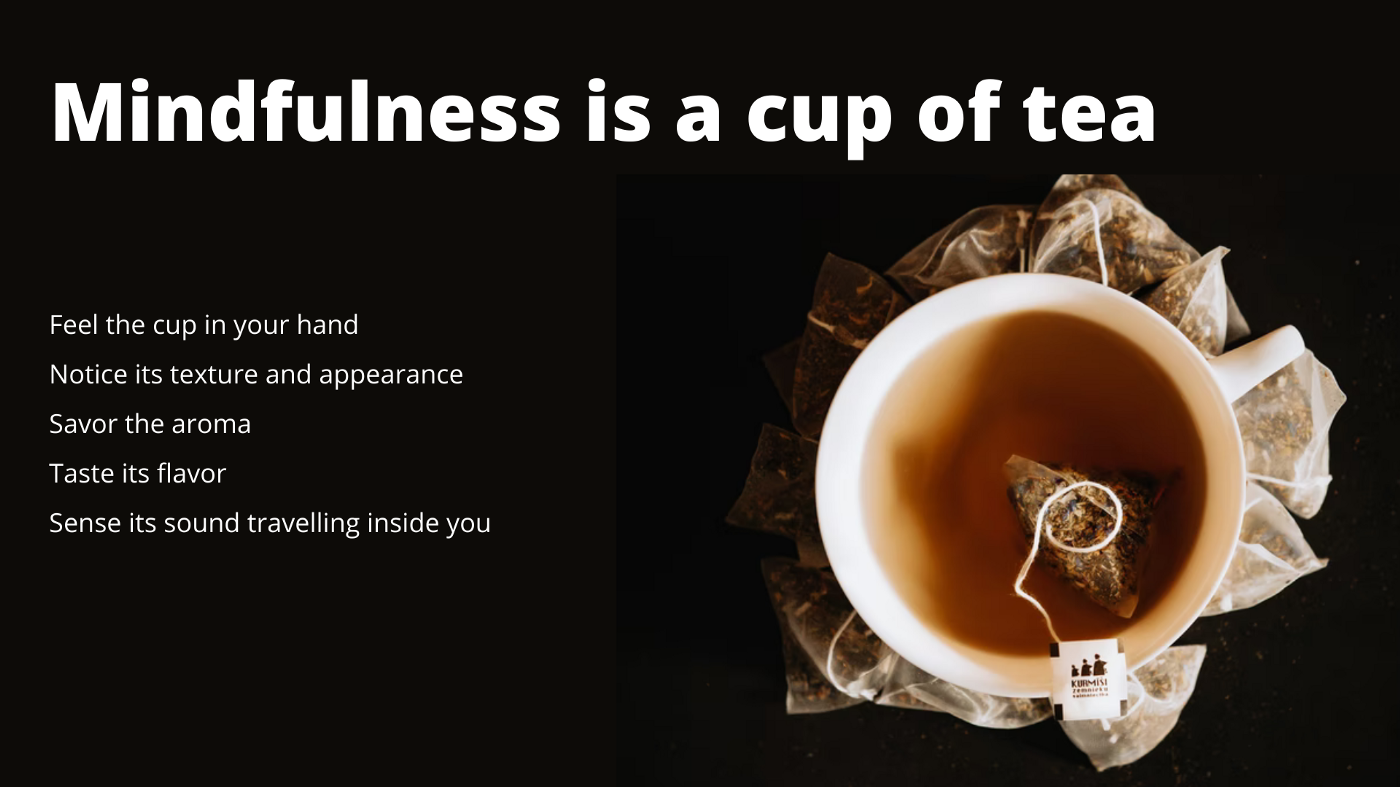
Teresa guided participants to build moments of mindfulness into the day to connect our mind and body through simple exercise of enjoying a cup of tea with our five senses. Highly recommended!
Open Space Sessions
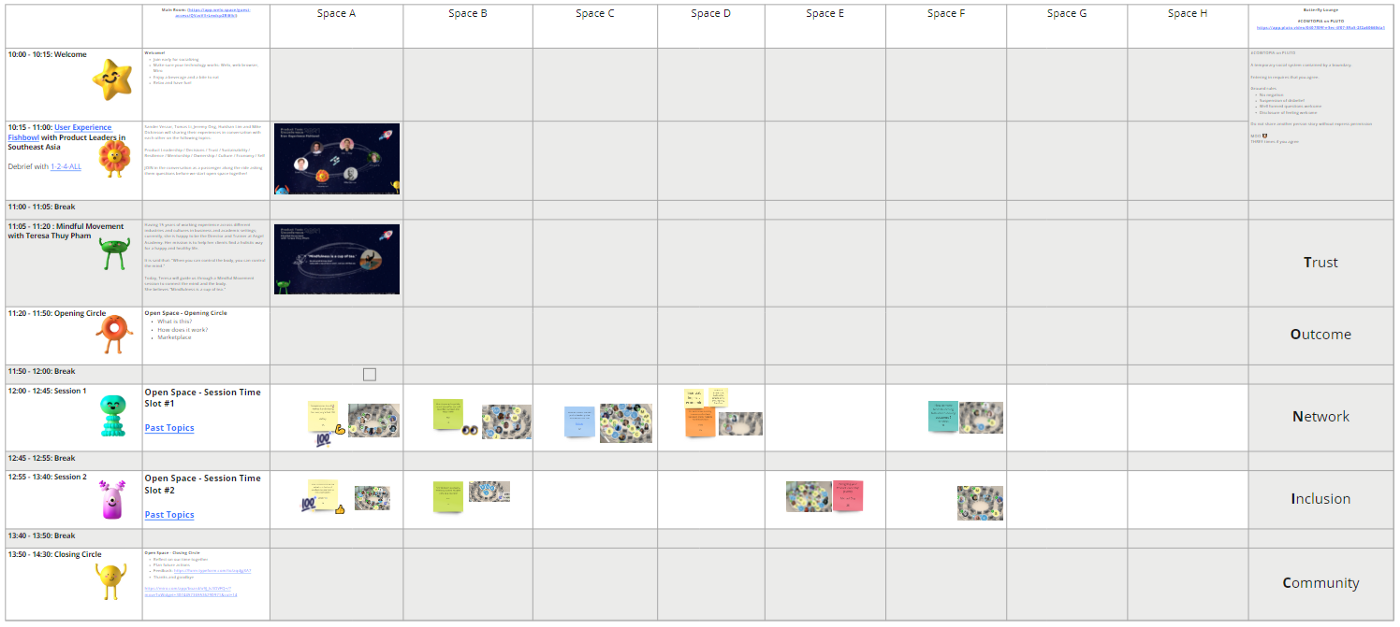
8 topics were launched:
- What do some of the best product leaders you’ve worked with look like?
- How do you recharge/take care of yourself as you hold space for your team and move them? (notes by Kiat Lim)
- Designing your Product leadership journey (notes by Michael Ong)
- One-(Wo)Man Band 🥁: How to handle being the company’s first PM?
- How to communicate the value/contribution of product management to the organisation?
- How to move from launching features to driving outcomes?
- First 90 days in a company
- For various sustainability, how can product leads transform charity model to social businesses (financial, impact, economic)
Closing and Check-Out
- When it’s over, it’s over — we did a gallery walk and
- Reflect on our time together
- Plan future actions
- Be safe as we exit the space
Notes on Virtual Unconference Experience
As reported in The Economist and study by Stanford Univ — a year since the pandemic, many already are suffering from ‘Zoom fatigue’ with the amount of virtual meeting, events and webinars organized and with the way the technology is designed: randomly arranged grids, awkward silences, endless eye contact, lack of social and non-verbal cues to build trust, and more. There have been efforts to recreate in-person events experiences and interactions online more bearable, such as:
- Microsoft Teams “Together Mode” which removes visual distractions and places participants as if they are in the same room to make meetings feel more natural and help participants focus on non-verbal cues.
- Gather Town, which is sort of a cross between Zoom and 8-bit retro video games with the ability to move around and interact with other participants based on your avatar’s locations.
- Upcoming Meta’s Horizon Workrooms and Microsoft Metaverse Mesh which bring VR-based immersive meeting space with expressive avatars for sense of presence and physical gestures using hands for more natural interactions
Yet, the one I’m excited the most comes through the way this Unconference is designed and run.
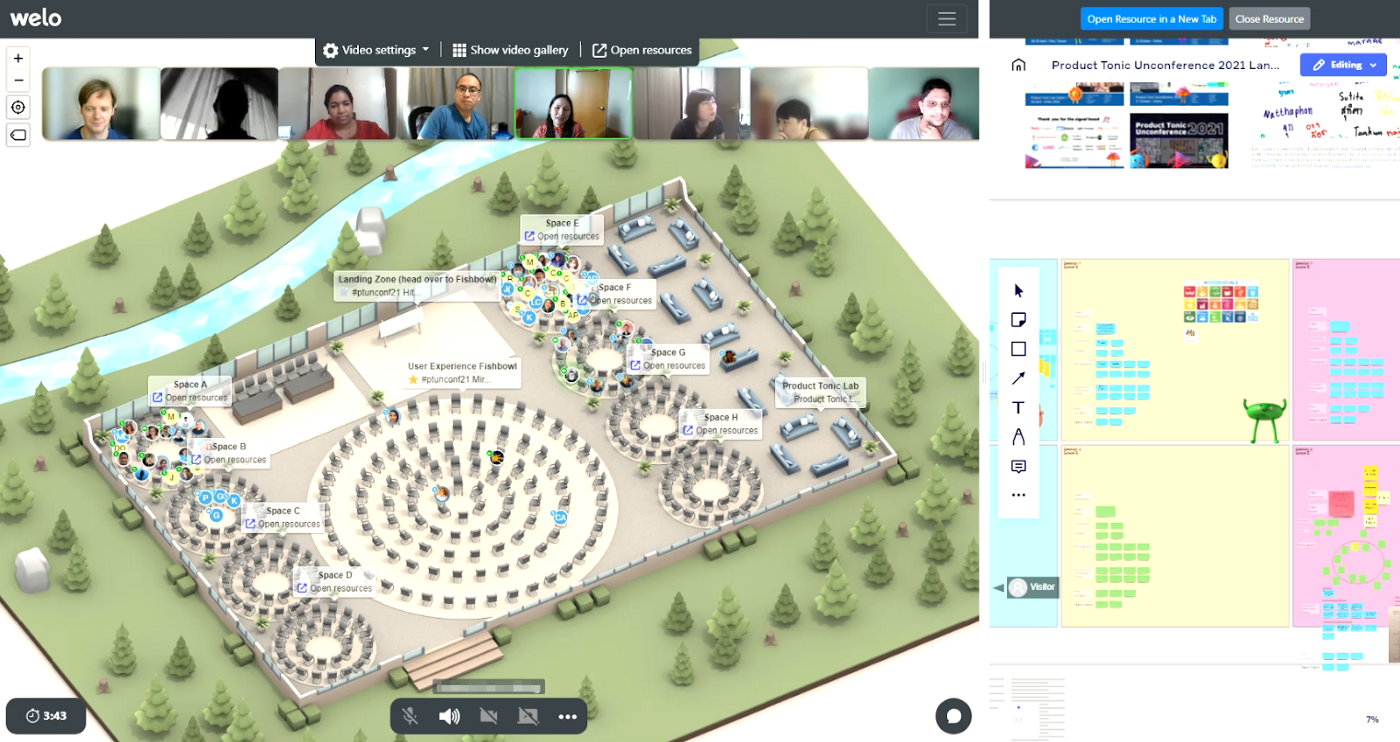
This year, the organiser chose to experiment using Welo Space — a relatively new player with great potential. I’m impressed with how well thought-out features provided:
- Beautifully designed 3D spaces providing clear cues of sessions buzzing with activity.
- Background Blur Camera mitigating privacy concerns for turning on camera
- Seamless integration with collaboration apps like Google Docs and Miro (a real time online whiteboard) therefore less tinkering & context switch with multiple windows
3D environments may first appear as gimmicky (nice to see but no real value) — however I began to appreciate how such environment can really help with spatial cues for effective social interaction. It becomes clearer to signal intention to participate by moving in and out from the circle and easier to notice such subtle cue as compare to raised hand emoji. Their space designs could help participants feel different vibes (e.g. formal, informal) and sense of connections to surrounding others. I’m also glad there’s no awkward keyboard to navigate around — simply double click to teleport across rooms. You can also have the choice for a quiet retreat space to focus without distractions while still staying present. This is the kind of solution that I found deliver more effective human connection in a Hybrid Digital Workplace.
Overall, the Unconference shows how impactful the dialogue could be with the right combination of facilitation skills, technology platform and participants.